1968 Dime Coin Value: How Much Is It Worth?
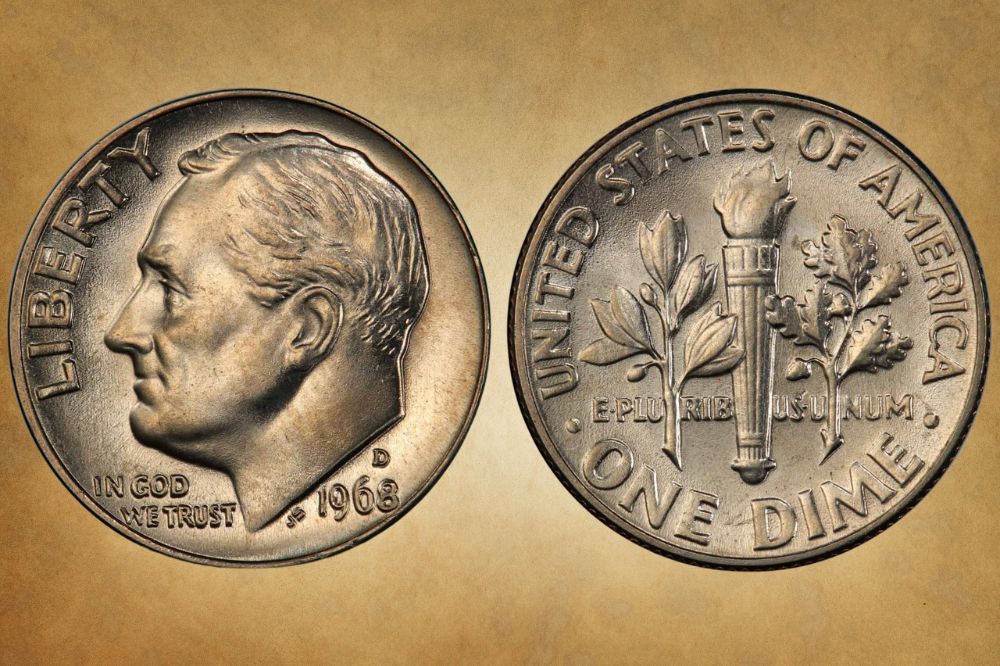
The 1968 Dime was a Roosevelt Dime. It was minted to honor Franklin Delano Roosevelt (FDR). He was the 32nd US President and was placed on the dime shortly after he died. This was mainly to celebrate his role in the March of Dimes, a campaign to fight against polio. The 1968 Dime Value is driven by its position as one of the first coins minted after the shortage.
1968 Business Strike Dime Value Chart |
||||||||
| Mint Mark | AU 58 | MS 60 | MS 63 | MS 64 | MS 65 | MS 66 | MS 67 | MS 68 |
| 1968 (P) No Mint Mark Dime Value | $1 | $4 | $5 | $6 | $10 | $16 | $40 | $475 |
| 1968-D Dime Value | $1 | $4 | $5 | $6 | $10 | $16 | $40 | $475 |
1963 Proof Strike Dime Value Chart |
||||||||
| Mint Mark | PR/PF 64 | PR/PF 64+ | PR/PF 65 | PR/PF 65+ | PR/PF 66 | PR/PF 67 | PR/PF 68 | PR/PF 69 |
| 1968-S Dime Value | $3 | $3 | $4 | $4 | $5 | $6 | $7 | $10 |
| 1968 No-S Dime Value | $11,500 | $11,750 | $12,500 | $12,650 | $13,000 | $20,000 | $22,000 | $50,000 |
1968 Dime Value Guide
The first factor that affects the 1968 Dime Value is its condition. The surest way to confirm this is to send it to a grading company like NGC (Numismatic Guaranty Company), ANACS (American Numismatic Association Certification Service), or even PCGS (Professional Coin Grading Service). They all use variants of the Sheldon Grading Scale that goes from 1 to 70.
The second factor is whether the coin is a regular / business / circulation strike or a special strike. Circulation coins are for everyday use and are graded from 1 to 70. Special coins are aimed at collectors, and they include Proof Coins, Uncirculated Sets, Enhanced Circulated Sets, and Special Mint Sets. They’re also graded from 1 to 70 but they use different letters.
The most common grades are PR/PF for Proofs and SMS/SP for Special Strikes or Special Mint Sets. Occasionally, regular strike coins have qualities that are similar to proof coins so they’re graded PL for Proof-Like, DPL for Deep-Proof-Like, or DMPL for Deep-Mirror-Proof-Like. Damaged or altered coins are graded Details, Brilliant Uncirculated, Choice, or Gem.
With Roosevelt Dimes, you might see an extra grade called FB or FT. This means Full Band (by PCGS) or Full Torch (by NGC). They both describe the horizontal lines on the torch that sits in the middle of the coin. If the details on the torch are clear enough to count the stripes, that coin is graded FB or FT. You can only get this grade on proof coins or mint state dimes.
The third factor is the mint mark. It shows which branch of the US Mint made the coin. A few other things that can influence the value of a coin are its mintage volumes, mint errors, rarity, and historical milestones like anniversaries. We’ll start by analyzing the coins based on their minting location and review sales records to confirm their past and current values.
1968 (P) No Mint Mark Dime Value
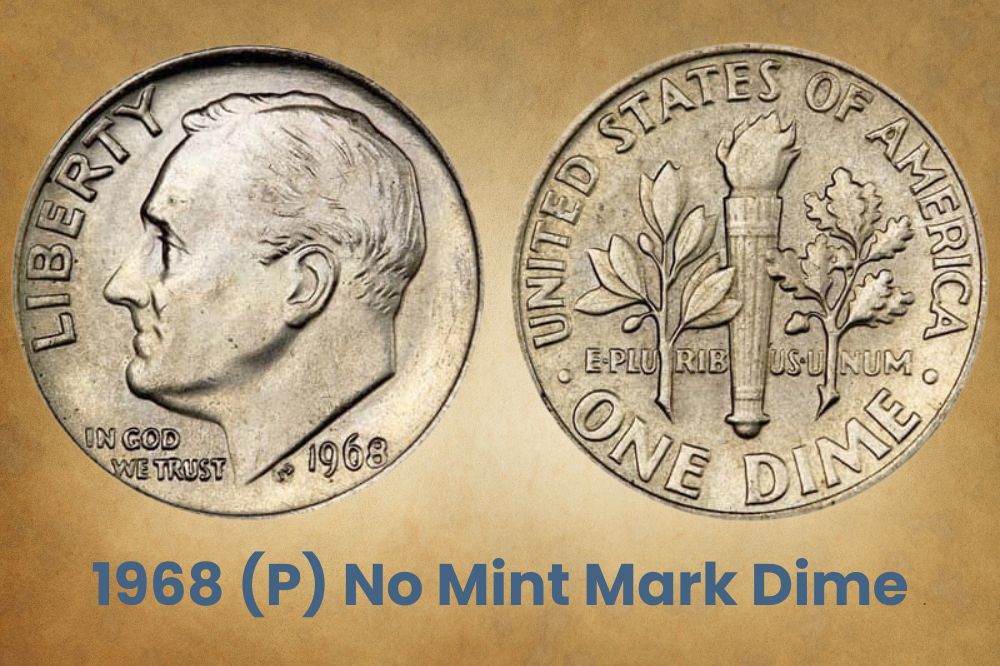
In 1968, the Philadelphia Mint made 424,470,000 Dimes without mint marks. Oddly, the highest recorded price for a 1968 Dime was a coin in the lowest possible grade – PO 1. It sold for $1,200 on eBay in June 2018. At the other end of the spectrum, the highest known grade is MS 68. PCGS has only graded two of them. One sample sold for $329 in February 2017.
PCGS sets the value for these coins as $475 in 2023. They’ve also graded one MS 67+ PL and estimated its price as $3,500, though it has never sold. Let’s look at Full Band coins. In April 2022, an MS 67 FB sold for $1,250 on eBay. But the highest grade submitted to PCGS so far is MS 67 FB. They have ten of these, so their value estimate for 2023 hovers around $500.
1968-D Dime Value
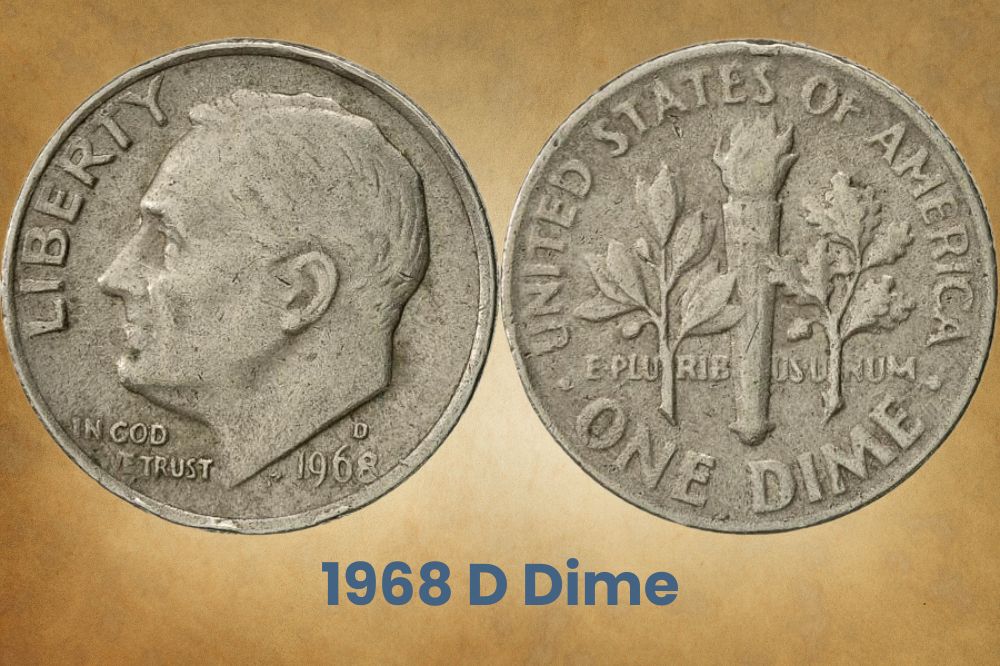
1968 saw 480,748,280 Dimes coined at the Denver Mint, all with the D Mint Mark. In April 2022, an MS 68 sold on eBay for $750. Only five are known, but their value estimate was down to $300 in 2023. An MS 68 FB fared better, selling on eBay for $1,495 in June 2021. PCGS has graded 11 coins at this level and estimates their value in 2023 as $800 per coin.
1968-S Proof Dime Value
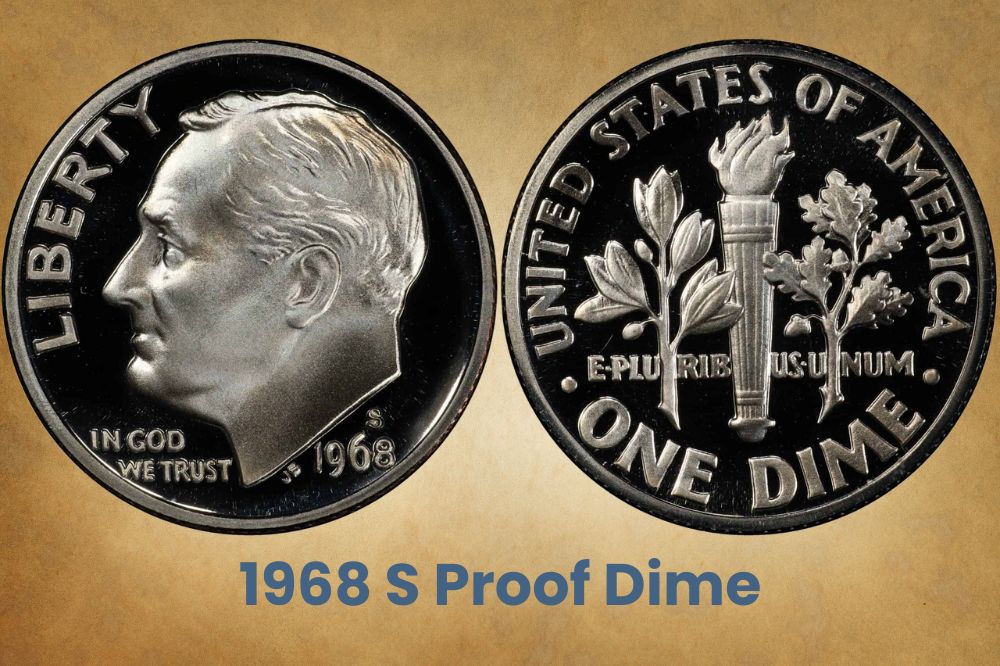
The San Francisco Mint made 3,041,506 Proof Dimes in 1968. They had the S Mint mark and were mirror-like proofs, which means they had a highly reflective field and a frosted device. By 1971, the mint had developed new techniques to make these coins more consistent. But in 1968, they were still frosting coins by pickling the proof die in acid, though it wasn’t durable.
Every time the die struck a planchet, the acid wash would fade a little more. As a result, older proof dies come in three grades. Deep Cameo or Ultra Cameo described the first 50 to 100 coins with the strongest contrast between the device and the field. The next hundred or so were cameo coins and the rest were standard proof coins. But how do the coins get so shiny?
The proof die is scrubbed with a horsehair brush, and the planchet is polished. To burnish these planchets, they’re tumbled in a vat full of 6mm stainless steel balls before the coin is struck. The balls or beads are called satellites and the coins are later rinsed to remove any residue. The coin is fairly common and doesn’t fetch high prices since it’s easily available.
In February 2008, a PR 70 sold for $196 and in October 2019 a PR 69 was just $20. PCGS has graded over 2,000 coins as PR 69 so it estimates their 2023 value at a mere $10. PR 70 CAM dimes do better since only one is known. In May 2022, it sold for $2,650 on eBay. In October 2006, a PR 69 DCAM was $575. Only one PR 70 CAM is known, priced at $13,500.
1968 No-S Proof Dime Value
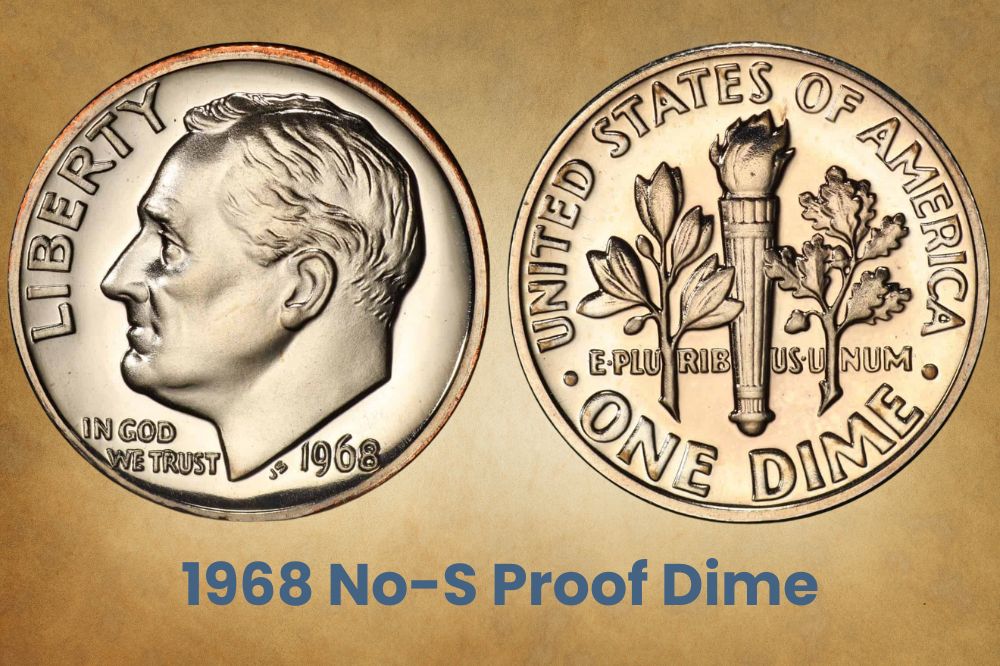
The No-S Proof Dime is a mystery because the mint has no records to explain it. 1968 was the first year when mint marks were restored after the 1965-to-1967 Coin Shortage when all branches of the mint produced coins without mint marks. This was expected to alleviate the shortage since Mint Director Eva Adams believed collectors were hoarding mint mark coins.
So the 1968 No-S Dime could be an innocent oversight. It has happened again in different years and denominations e.g. 1970 Dimes, 1971 Nickels, 1975 Dimes, 1976 Ike Dollars, and 1990 Pennies. But it’s a rare mint mistake, and the 1968 No-S Dime was the first one. It’s a pretty pricy coin in general. A PR 67 was $40,250 in July 2008 and only one PR 69 is known.
The MS 69 DCAM is estimated at $50,000 in 2023. Meanwhile, a PR 68 CAM was $48,875 in September 2006. A PR 69 CAM was $45,600 in December 2022 and since only two are known, their price estimate for 2023 is $65,000. But PCGS has only graded one 1968 No-S PR 68 DCAM. It was $6,000 in 1997, $32,300 in 2005, and $47,000 in December 2020.
Related Posts: 16 Most Valuable Dime Errors
1968 Dime Errors
Mint mistakes can make a coin more valuable. They’re more common on older coins because the three minting stages were manual. After the artist brought his/her 8” model to the mint, it was popped into a reducing machine to make the steel master hub. This took several days. A batch of steel master dies, working hubs, and working dies were made using this template.
Finally, mint marks were punched onto the working die by hand, then the working die struck planchets to make coins. These procedures needed at least two strikes each, and if the metal moved mid-strike, you might get mint errors like misalignment, doubling, tripling, or even quadrupling. Other mint mistakes include striking coins on a planchet meant for other coins.
1968 (P) Dime DDO Error
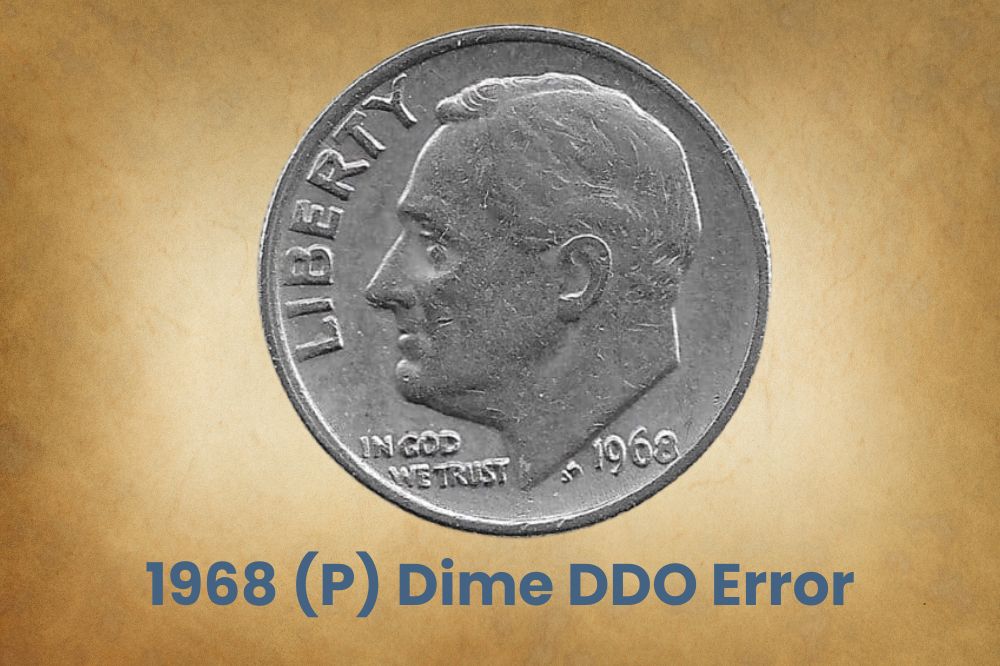
A doubled-die error or DDO happens when the second hub strike lands on a different spot from the first strike. This results in a doubling effect that gets reproduced on every coin the error die mints. In December 2011, an MS 65 DDO sold for $159 and in April 2022, an MS 66 DDO sold for $104. Almost 30 coins exist in this grade so their 2023 price estimate is $115.
1968-S Proof Dime DDO Error
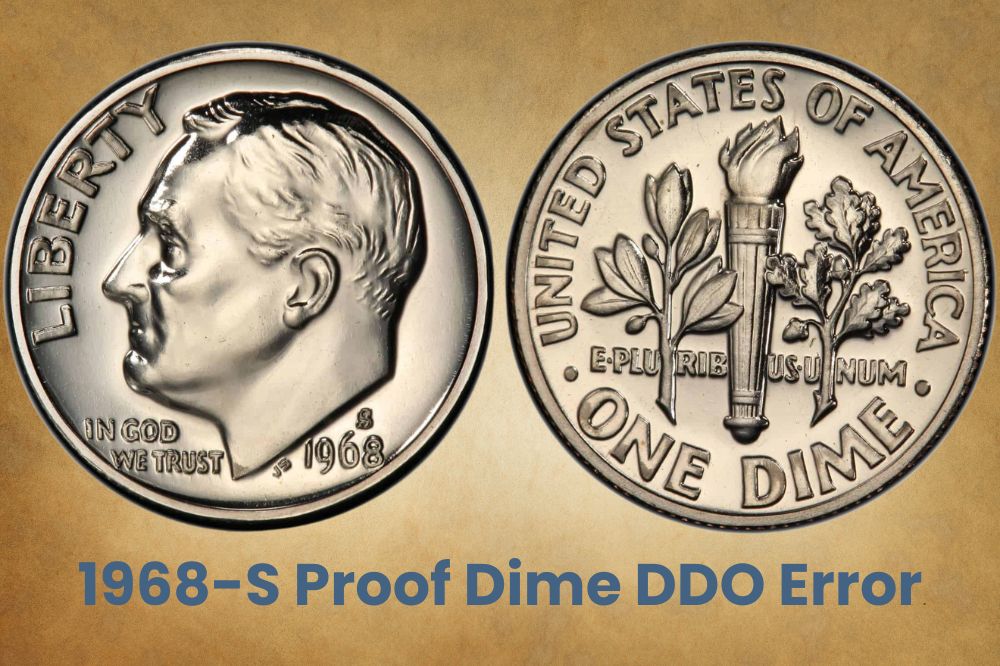
The pricing for DDOs on the San Francisco Proof Dime isn’t that different from its business strike Philadelphia cousins. In May 2022, a PR 68 sold for $332. PCGS has graded 15 of these coins and places their value at $315. Meanwhile, in 2023, a PR 68 CAM is estimated at $500 while a PR 69 CAM is evaluated at $600. PCGS has graded one of each and sold none.
1968-S Proof Dime DDR Error
Image: ebay
A DDR is similar to a DDO except it happens on the reverse die, hence doubled-die reverse. In May 2018, a PR 69 sold for $429 on eBay. Two coins are known, and PCGS estimates their value as $600 in 2023. They’ve also graded one PR 68 CAM and one PR 68+ CAM. Neither coin has sold so far, but their 2023 value estimates are $375 for the 68 and $550 for the 68+.
1968-S Proof Dime S/S RPM Error
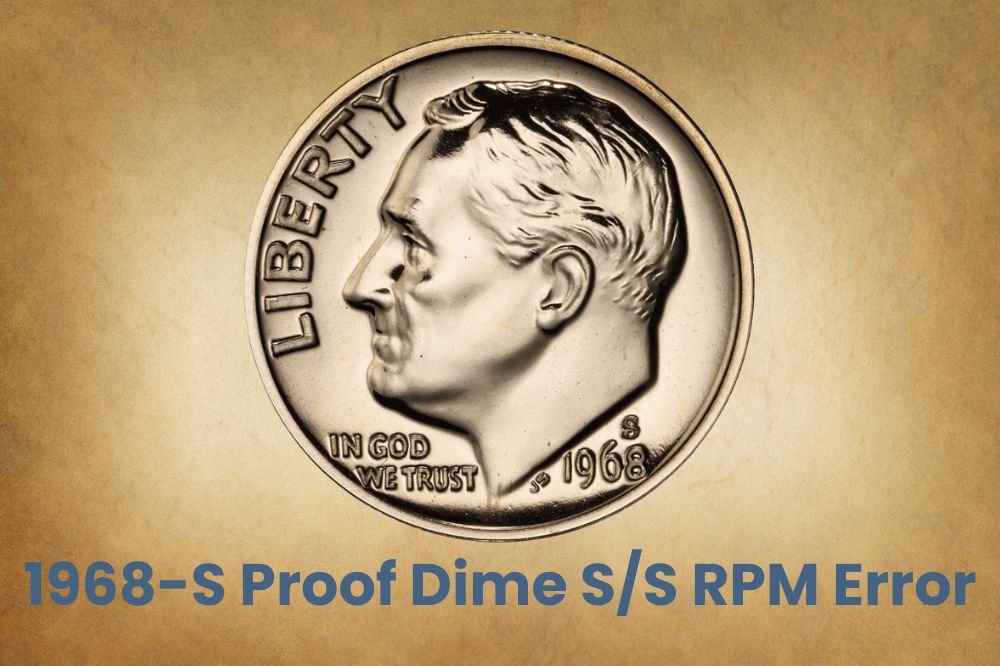
Until 1990, mint workers would use a hand puncheon to place the mint mark on a working die. So if the die moved or the hand wobbled, the second or third strike landed elsewhere. It’s called a re-punched mint mark (RPM) and you can see traces of the earlier mint mark below. In August 2015, a PR 67 S/S was $590, and a PR 68 CAM S/S sold for $1,000 in July 2021.
1968-D Dime Missing Clad Layer
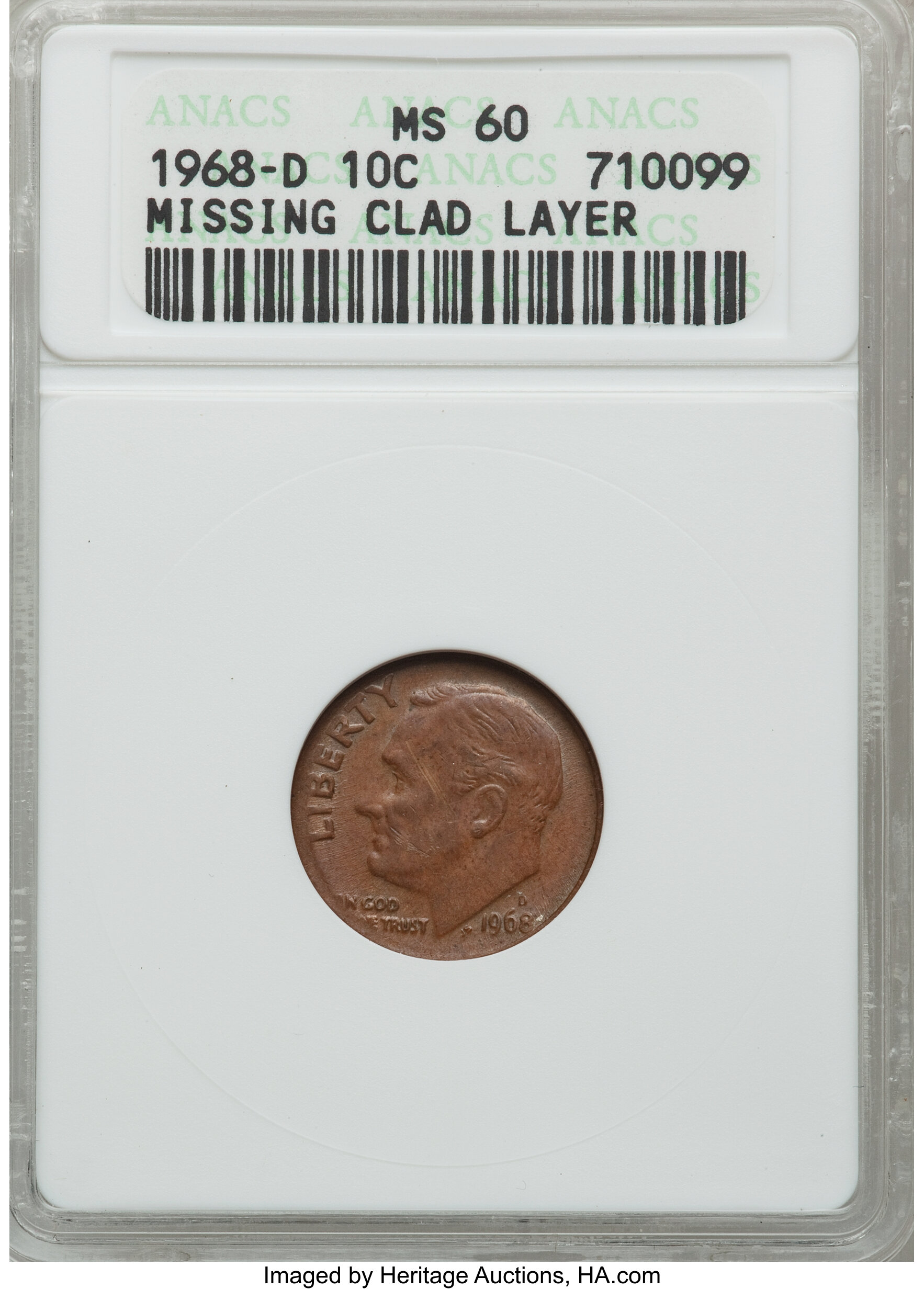
1968 Dimes have pure copper innards coated with a cupro-nickel alloy of 75% copper and 25% nickel. If the outer layer is missing, you’ll see FDR’s features on a coin that looks like a mini-penny. The coin might also be slightly lighter than the 2.3g you typically see on a dime. A coin graded MS 60 by ANACS sold for $89. Only the obverse was missing its clad layer.
1968-D Dime Struck on a 1g Fragment
Coins are usually struck on disc-shaped planchets that are punched out of a metal sheet. After punching, the sheet is full of holes and some can break into fragments. Some of these may accidentally slip into the coin hopper and be fed into the press. This example shows a half-circle fragment with FDR’s nose and forehead sliced off. In AU 58, it sold for over $140.
1968-D Dime Struck on a Silver Planchet
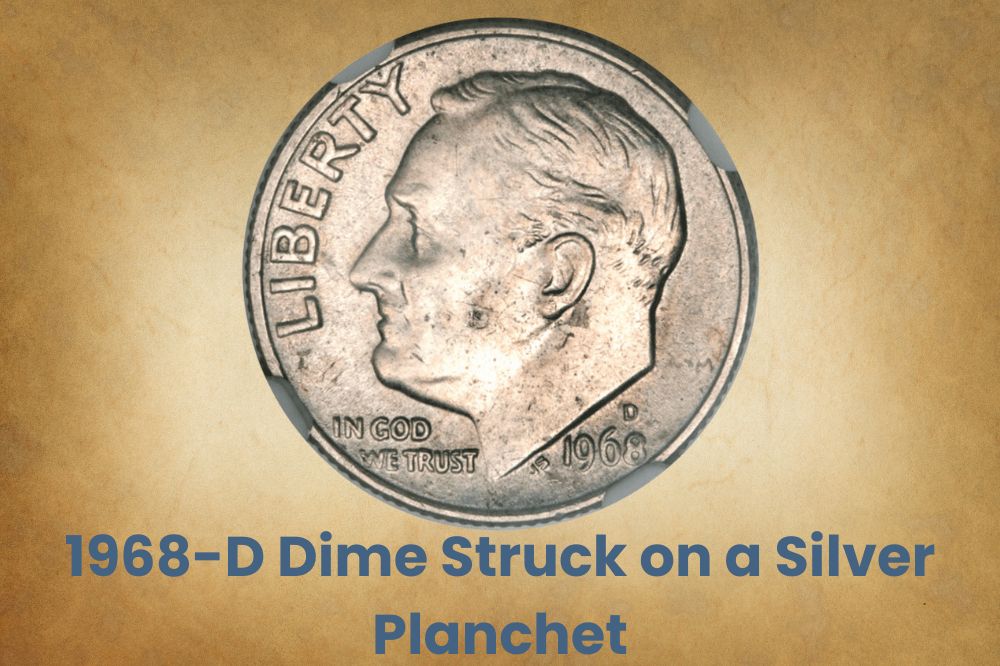
Earlier dimes were 90% Silver and 10% Copper. They weighed 2.5g while cupronickel-clad planchets are lighter at 2.268g (commonly rounded up to 2.3g). This error coin was struck on a silver planchet instead of a clad one, and you can tell by weighing it. It would also sound different if you dropped or pinged it. In AU 55, this precious metal coin sold for over $5,700.
1968-D Split After Strike
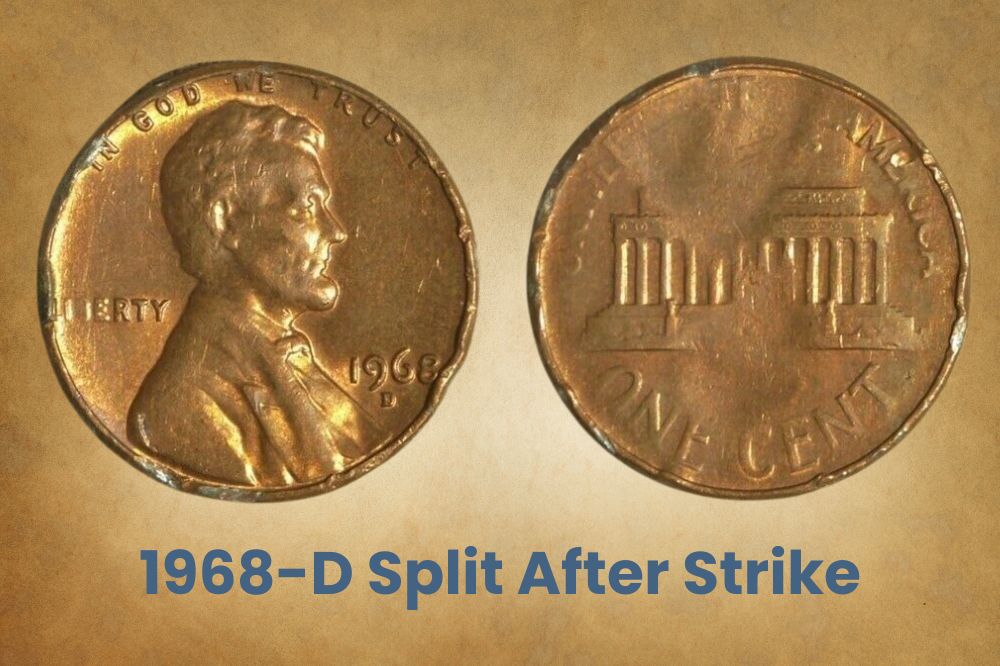
At first glance, you can’t be sure what happened to this coin. Turns out the planchet was defective and its alloy hadn’t fully fused. So after the coin was struck, it split edgewise, producing two super-thin coins with mirror-image designs. One of the split sections seems double-headed and has no tails side since the reverse sheared off. In MS 60, it sold for $138.
Related Posts: 22 Most Valuable Roosevelt Dimes Worth Money
History of the 1968 Dime
FDR was the fourth American President to be honored on a US coin after Abraham Lincoln on the penny, George Washington on the quarter, and Thomas Jefferson on the nickel. The coin was a tribute to his anti-polio initiative. He died shortly before he was selected for the coin, and it was intended as a memorial. But not everyone felt he deserved that silver spot.
In the prior 40 years, coins had been designed by external artists because politicians – and the public – felt the pre-1909 coins designed by in-house mint engravers were ugly and way too conservative. But FDR died on April 12th, 1945 and people wanted his face on a coin by January 30th which would have been his 64th birthday. So the coin had to be minted quickly.
To save time, the mint decided to have its Chief Engraver – John Sinnock – design the coin. He had sculpted an earlier FDR Presidential Medal, so it made sense to give him the task. The Commission of Fine Arts disliked his models and made endless edits before approval. Also, he was unwell. His assistant, Gilroy Roberts, did most of the work but wasn’t credited.
So when the coin was finally released, conspiracy theorists spread rumors that the initials on the coin, JS, stood for Joseph Stalin rather than John Sinnock. The Communist Panic was rampant at the time, and the US Mint had to aggressively and officially deny this fake news. He was also accused of plagiarising the portrait from African American artist Selma Burke.
Related Posts: 18 Most Valuable Mercury Dimes Worth Money
How to Identify 1968 Dime?
You might come across some unfamiliar words as you study coins, so let’s begin with a brief primer. Coins are minted on blank discs called planchets. The heads side of a coin is called its obverse and its tails side is called its reverse. The thinnest sides of the coin are called its edges. They sometimes have ridges called reeds, but they can also be left smooth or plain.
The rim or collar is the raised border that defines the shape of the coin. The words that appear on a coin are called legends or mottos and the images are known as devices. A coin’s background is called its field. Many coins also have a mint date and various monograms or initials. These include the mint mark and the signature of the artist who sculpted the coin.
The Obverse of the 1968 Dime
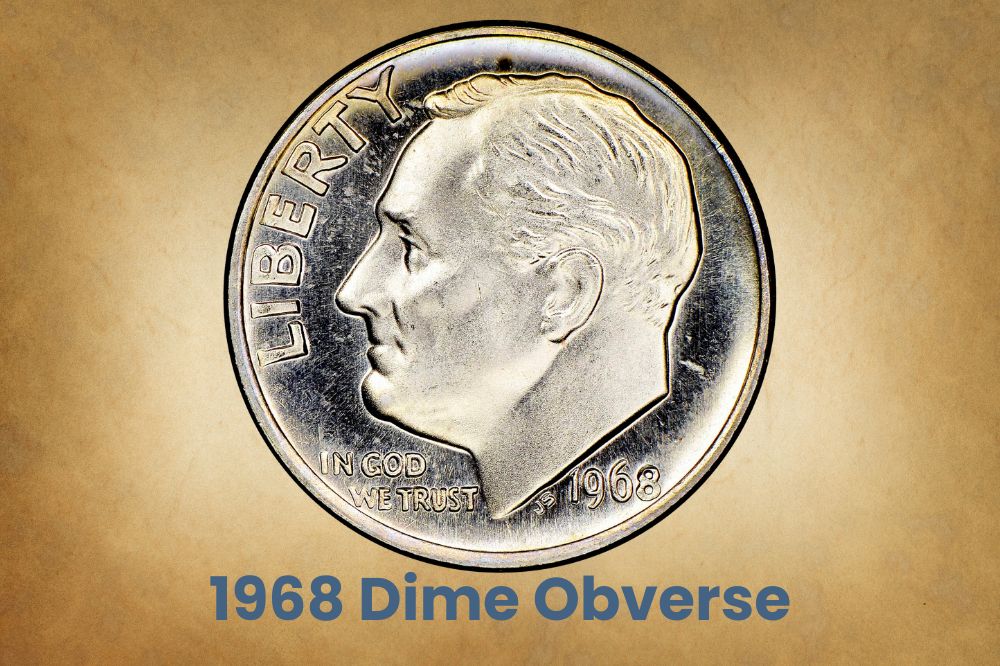
The obverse (heads side) of the 1968 Dime shows a profile of Franklin Delano Roosevelt facing left. The legend Liberty is on the upper left, in front of his face, and the motto In God We Trust is also on the left, under his chin. The initials JS for John Sinnock are on the lower right, under his neck. They’re immediately followed by the mint date and the mint mark.
The Reverse of the 1968 Dime
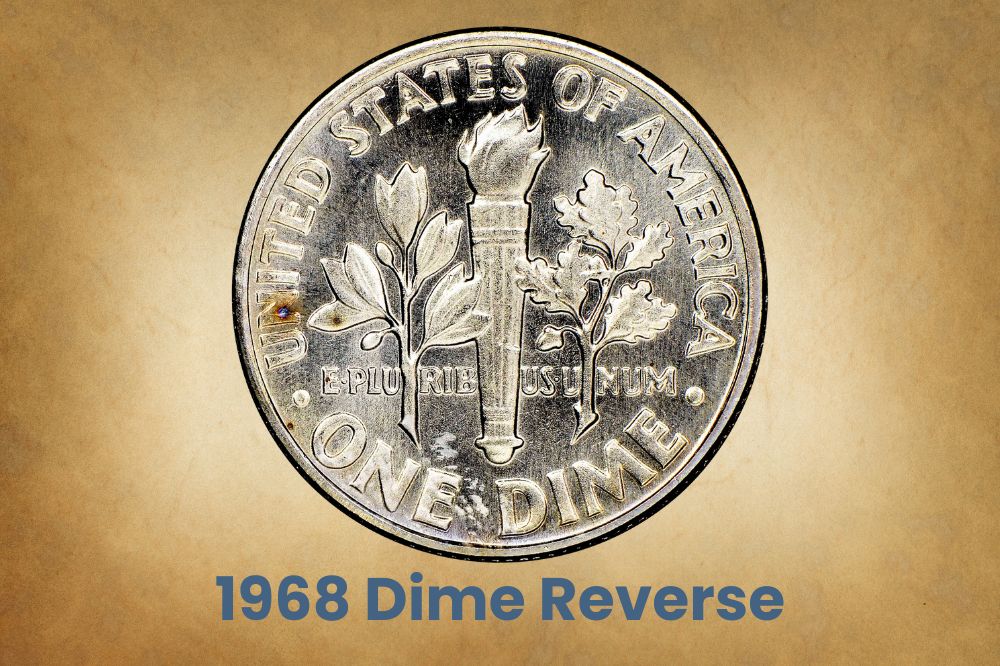
The reverse (tails side) of the 1968 Dime has the legend United States of America. It runs along the top and sides of the coin, with a dot before and after the phrase. The denomination One Dime is on the lower rim of the coin. The middle of the coin has three devices, namely an oak branch, flaming torch, and olive branch. E Pluribus Unum is spread between them.
Other Features of the 1968 Dime
The 1968 Dime is a clad cupro-nickel coin that’s 91.67% copper and 8.33% nickel. The planchet sheet has pure copper in the middle while the outer coat is 75% copper and 25% nickel to give the coin its silver color. This dime is 17.91mm in diameter (0.705 inches), is 1.35mm thick (0.053 inches), and weighs 2.268g. The coin’s edge is engraved with 118 reeds.
Related Posts: 17 Most Valuable Dimes Worth Money
Is a 1968 Dime Rare?
Not really. Lots of them are in circulation, which is why mid-mint states are only worth $10. But the 1968 No-S Proof Dime is extremely rare. PCGS has only graded a handful in PR 68+, with only three confirmed sales in 1997, 2005, and 2020. Less than 20 exist in all grades.

I have a 1968 dime, only the lower quarter of the coin was printed.